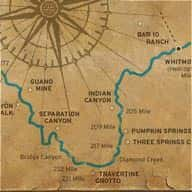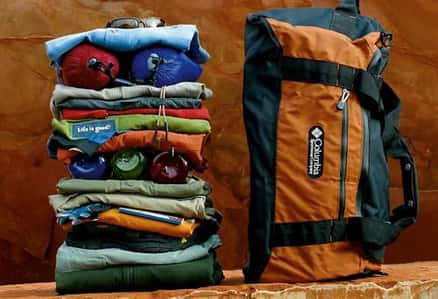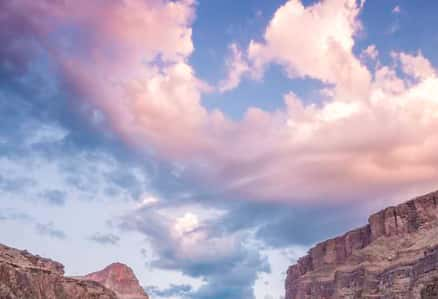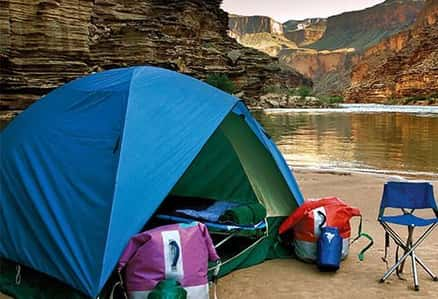An adventure vacation such as a river trip down Desolation Canyon can provide experiences and memories that will last a lifetime. We want you to enjoy your river trip as much as possible. In order to do this, it is necessary that you understand the physical requirements of the trip. Health determinants such as age, weight, lack of physical conditioning, degenerative brain disease, and diseases or conditions associated with the heart and lungs may become intensified due to the unpredictable environment and distance from hospitals. Understanding these risks along with the possible strenuous physical activity that accompanies whitewater rafting trips of this nature will help you be better prepared for this trip of a lifetime.
- Balance
Caloric Expenditure with Caloric Intake
- A rafting adventure with Western River
Expeditions is a wonderful mix of physical excursion, relaxation, and
tempting gourmet foods. It’s important to make sure you eat a
well-balanced diet to keep your body fueled for each day’s adventures. If
you have allergies or other dietary restrictions, please see the “Food
& Beverage” tab found on this same page. Please note that all allergy
and dietary restriction information should be shared with our
detail-oriented reservation staff before final payment is due.
- A rafting adventure with Western River
Expeditions is a wonderful mix of physical excursion, relaxation, and
tempting gourmet foods. It’s important to make sure you eat a
well-balanced diet to keep your body fueled for each day’s adventures. If
you have allergies or other dietary restrictions, please see the “Food
& Beverage” tab found on this same page. Please note that all allergy
and dietary restriction information should be shared with our
detail-oriented reservation staff before final payment is due.
- Be
Self-Sufficient & Responsible
- A river trip such as this requires active
participation from each guest. Our wonderful guides will do their best to
ensure the safety and welfare of each guest on the trip, but you are also
responsible for your personal safety. The guides fill their long days
with varying responsibilities, so they will not be able to devote a lot
of extra time to any one individual throughout the trip.
- A river trip such as this requires active
participation from each guest. Our wonderful guides will do their best to
ensure the safety and welfare of each guest on the trip, but you are also
responsible for your personal safety. The guides fill their long days
with varying responsibilities, so they will not be able to devote a lot
of extra time to any one individual throughout the trip.
- Carry
Your Personal Gear Bag
- You must be able to carry your own gear bag
which holds your 20-pound duffle bag and sleeping bag, a tarp, and bed
sheets. You will also be required to set up your own cot and tent after
the guides demonstrate how to do so. You will decide where you set up
your personal camp and take your duffle bag. You’ll be responsible to
take your gear where you want it and return it back to the boat the next
morning.
- You must be able to carry your own gear bag
which holds your 20-pound duffle bag and sleeping bag, a tarp, and bed
sheets. You will also be required to set up your own cot and tent after
the guides demonstrate how to do so. You will decide where you set up
your personal camp and take your duffle bag. You’ll be responsible to
take your gear where you want it and return it back to the boat the next
morning.
- Grip
Ropes & Paddles
- The type of boats we use on the Green River
down Desolation Canyon is great for families and individuals of all ages
and abilities. Being able to grip ropes tightly with your hands is
important because it’s how you’ll stay inside the boat during the rapids.
If you are in an inflatable kayak, you’ll need to paddle intensely (using
your abdominal muscles, leg muscles, and arm & shoulder muscles) at
times. This will get you through both the rapids and some flatwater
sections of the river. Ask a member of the reservations staff what type
of boat(s) are available during your trip date for more information.
- The type of boats we use on the Green River
down Desolation Canyon is great for families and individuals of all ages
and abilities. Being able to grip ropes tightly with your hands is
important because it’s how you’ll stay inside the boat during the rapids.
If you are in an inflatable kayak, you’ll need to paddle intensely (using
your abdominal muscles, leg muscles, and arm & shoulder muscles) at
times. This will get you through both the rapids and some flatwater
sections of the river. Ask a member of the reservations staff what type
of boat(s) are available during your trip date for more information.
- Assist in “Self-Rescue”
- It is possible that you could fall out of
the boat or that the boat could capsize. In the event that this happens,
you will need to be able to self-rescue by either swimming back to the
boat or to shore. If you swim to shore, you may have to traverse over
rocks, tree limbs, and other natural obstacles to get to the boat
downstream. Your guide will point you in the direction of safety if
anyone falls out of the rafts or kayaks.
- For participants who have heart conditions
or who are very overweight, falling out of the boat during a rapid or
other highly intense situation could possibly result in a “cold-water
immersion heart attack”. Such attacks occur when the person swimming
cannot calm their breathing and the heart does not receive enough oxygen.
- It is possible that you could fall out of
the boat or that the boat could capsize. In the event that this happens,
you will need to be able to self-rescue by either swimming back to the
boat or to shore. If you swim to shore, you may have to traverse over
rocks, tree limbs, and other natural obstacles to get to the boat
downstream. Your guide will point you in the direction of safety if
anyone falls out of the rafts or kayaks.
- Navigate
Uneven Terrain
- The nature of this trip requires you to get
on and off boats regularly. You may be asked to get on or off the boat on
a flat, sandy beach or you may be asked to step onto boulders or a beach
with a steep grade. It may take as much as a 2-3 foot ascent to climb
onto the rafts. Also, the boats may have slippery and sandy surfaces at
any time. The boat may be tied off in swift water, which means it could
be swaying or rocking as you board or exit the raft.
- There will be opportunities to stop and
hike as we travel downriver. These hikes lead to ancient granaries, historic
hideouts, petroglyphs, pictographs, and incredible views. Not all hikes
are mandatory, but guests are required to get off the raft due to safety
concerns. If you have concerns about this, or would like to learn more
about the possible side hikes, please give our friendly staff a call.
- Our daily lunches and nightly camp will be
on sandy beaches. Again, this requires you to be able to get on and off
the boats on uneven terrain. Sand can be difficult to walk on, and each
night and morning you will be carrying your own gear bag, including your
20-pound duffle bag, sleeping bag, bed sheets, and tarp. Please note that
reaching the toilet facilities at night in the dark also requires
traversing irregular ground terrain.
- The nature of this trip requires you to get
on and off boats regularly. You may be asked to get on or off the boat on
a flat, sandy beach or you may be asked to step onto boulders or a beach
with a steep grade. It may take as much as a 2-3 foot ascent to climb
onto the rafts. Also, the boats may have slippery and sandy surfaces at
any time. The boat may be tied off in swift water, which means it could
be swaying or rocking as you board or exit the raft.
- Wear
Your Life Jacket
- In order to fit into this coast guard
approved, National Park Service required, Type V Whitewater life jacket,
you must weigh at least 50 pounds and have a chest size no larger than 52
inches. We have both “Adult” and “Youth” jackets. Youth jackets are for
those weighing between 50-90 pounds (23-41kg). Both adult and youth
jackets are adjustable in order to fit a range of chest sizes and body
types. If you have any concerns regarding the fit of a life jacket,
please contact our office staff. After a discussion, if you are still
unsure about the fit for either yourself or a child, we’ll mail you a
life jacket for you to try it on.
- Your guide will fit you to your life jacket
while on your adventure. For your safety, it is crucial that you wear
your life jacket as instructed. These Type V life jackets are very
effective at keeping your head above water; but if you are unable to swim
a threatening situation could arise, especially during a rapid-filled
section of the river.
- In order to fit into this coast guard
approved, National Park Service required, Type V Whitewater life jacket,
you must weigh at least 50 pounds and have a chest size no larger than 52
inches. We have both “Adult” and “Youth” jackets. Youth jackets are for
those weighing between 50-90 pounds (23-41kg). Both adult and youth
jackets are adjustable in order to fit a range of chest sizes and body
types. If you have any concerns regarding the fit of a life jacket,
please contact our office staff. After a discussion, if you are still
unsure about the fit for either yourself or a child, we’ll mail you a
life jacket for you to try it on.










